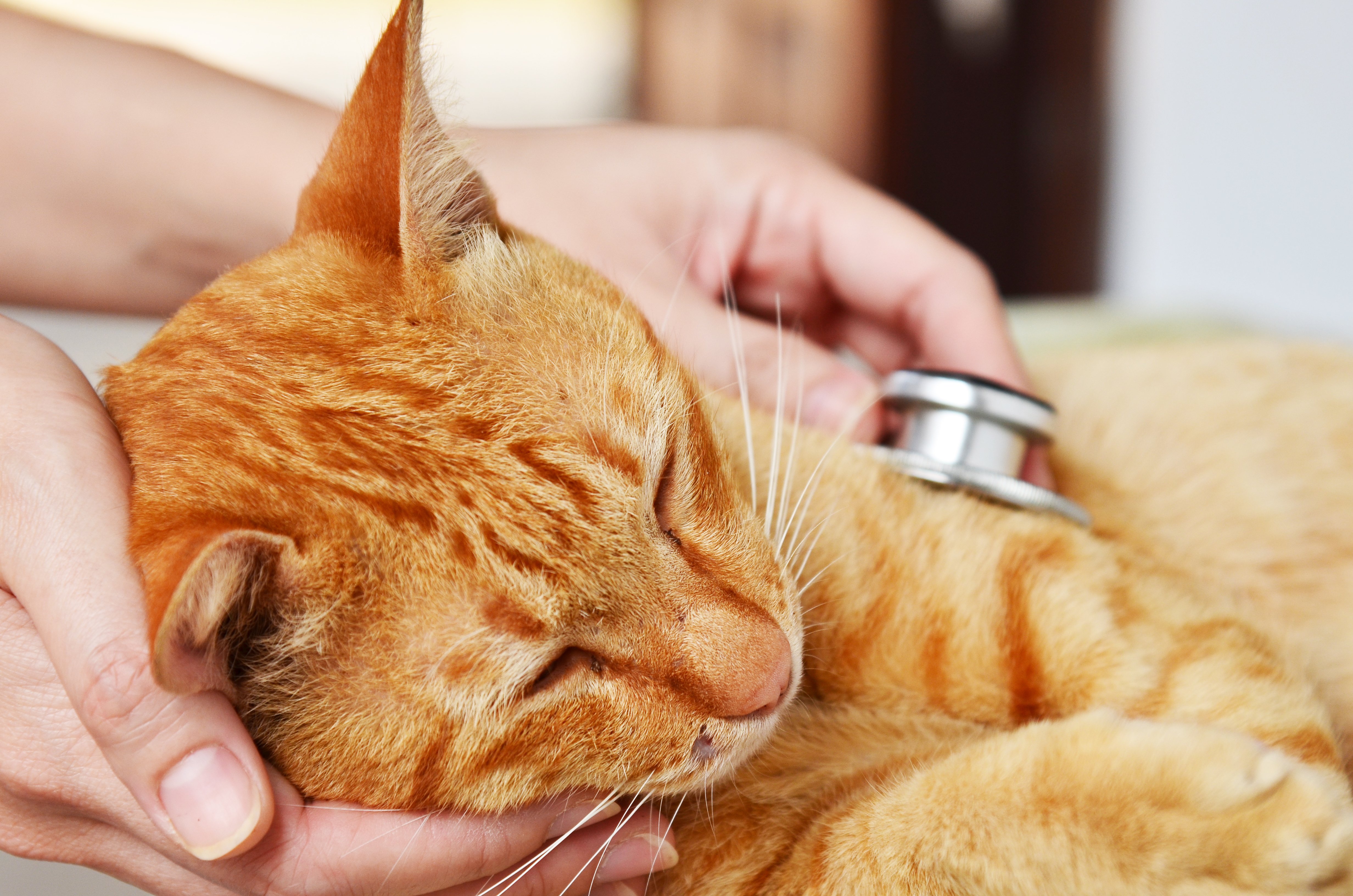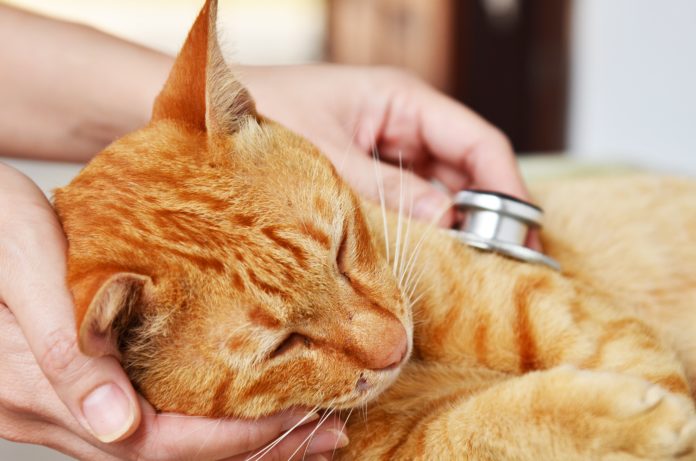
At the most basic level, “shock” is when something causes the body to shut down and fail to function properly. This is largely due to malfunctions in or damage to the circulatory system leading to low blood pressure, which makes it difficult to get sufficient oxygen to the tissues.
Shock has many potential causes, including trauma, severe burns, infection, allergic reaction, severe heart disease, or another serious systemic illness.
Types of Shock
While shock is always a veterinary emergency, understanding the different classifications of shock can help you understand what is happening in your cat’s body if he goes into shock:
Anaphylactic shock is an immediate allergic reaction that happens within minutes of exposure to the triggering insect bite, injection, or food. Symptoms include difficulty breathing, pale gums, cold feet/legs, an elevated heart rate with weak pulse, vomiting, diarrhea, drooling, agitation, facial swelling, seizures, coma, and even death.
Hypovolemic shock is when large amounts of blood are lost, causing low blood pressure and poor oxygenation of the body’s tissues. Hypovolemic shock is generally due to trauma, such as being hit by a car or attacked by another animal, but can also be caused by internal bleeding due to a health problem, such as cancer.
Septic shock is a dangerous drop in blood pressure and resulting organ failure in response to an infection in the bloodstream. Some bacteria produce toxins that cause the blood vessels to dilate, which lowers blood pressure. Cytokines, substances that the cat’s immune system produces to fight the infection, can be involved in causing vasodilation.
Signs include disorientation, elevated temperature, panting, and a rapid pulse. As the cat’s condition deteriorates, difficulty breathing, a drop in body temperature, fluid retention, and swelling can all occur as various organs fail.
Bloodwork is usually necessary to diagnose septic shock. The cat may have an abnormal white blood cell count, fewer platelets than normal, low blood-oxygen levels, and/or high levels of waste products. The offending bacteria can often be identified with a culture, but your veterinarian will proceed with supportive care while awaiting results.
Treatment
Shock is treated by stabilizing the cat and addressing the underlying cause. Because there are many different things that could cause a cat to go into shock, the exact treatment protocol will vary from case to case. Your veterinarian or a technician will ask questions to try to figure out what happened to cause your cat to go into shock, often while other team members are starting to work on your cat to support her respiratory and circulatory systems.
Fluids are a mainstay of treatment for shock because they help to improve the cat’s blood pressure. If the cat has low blood pressure due to blood loss from trauma, the fluids replace the volume of the missing blood, allowing the cat’s red blood cells to still adequately circulate through the body and bring oxygen to the tissues. If the cat has low blood pressure due to dilated blood vessels making the cat’s circulatory system too “big” for a normal volume of blood, the fluids fill up that extra space. Imagine that a quart-size bag of water is a healthy cat with good blood pressure (the bag is full, so the outside is smooth and taught like a water balloon). A cat whose blood vessels have dilated due to shock is more like a gallon size bag still with only a quart of water – the water sloshes around inside the bag, and the bag can fold in on itself. Fluids restore blood pressure until time and other medications and treatments can restore the cat’s circulatory system back to normal.
Fluids can make a difference. Some types of fluids draw water out of your cat’s cells and into the blood vessels, and different types are more or less likely to leave the vessels and enter the cells and interstitial spaces of the body. Which type of fluids is used depends on your cat’s condition, other treatment measures being taken, and what your veterinarian has available to work with. Blood transfusions are also an option.
A cat in shock will often receive oxygen, either via a mask hooked up to an anesthesia machine or through an endotracheal tube placed down his throat. Providing pure oxygen for the cat to breathe ensures that the cat’s red blood cells will be saturated with oxygen to bring to the tissues of the body.
Medications that may be used when treating shock include epinephrine, atropine, antihistamines, anti-inflammatory drugs, corticosteroids, and antibiotics. Epinephrine causes the peripheral blood vessels to constrict, which increases blood pressure and helps to maintain adequate circulation to all parts of the body. Atropine increases the heart rate and constricts blood vessels, both of which help to increase blood pressure. Antihistamines, anti-inflammatory drugs, and corticosteroids disrupt the inflammatory response. Antibiotics are appropriate for patients suffering from an infection.
Of course, prevention is the best medicine. Keep your cat safe from trauma by keeping him indoors and placing him in a carrier for travel. Vaccinations and regular veterinary exams will help keep him healthy and identify any developing health problems early. Finally, if you know your cat or one of his relatives has had a severe allergic reaction to something in the past, avoid that trigger going forward.
Perform Feline CPR
If you believe your cat’s heart has stopped beating and he is no longer conscious, start chest compressions immediately:
1. Open the mouth to be sure nothing is obstructing the airway.
2. Lay your cat on his side on a firm surface.
3. Place your hand over the cat’s heart, which lies under the ribs where the elbow falls against the body, and start chest compressions, which should be strong enough to compress the depth of the chest by 30 to 50 percent, allowing the chest to recoil completely between compressions. Note: If the cat is small, one hand will be enough. Wrap your hand around the cat’s chest, with your thumb over the heart on one side and your first two to three fingers over the heart on the other side. Wrap your hand around the cat’s underside, not the back. For large cats, two hands may be preferred. Place one hand over the other interlocking the fingers. The heel of your bottom hand should be over the heart.
4. Compress 30 times in 15 seconds (2 compressions per second) and then hold the cat’s mouth closed and breathe two short breaths into the cat’s snout (nose and mouth). Your mouth should make a seal over the cat’s snout. Blow strong, quick breaths into the nostrils to achieve a normal chest rise. Then immediately resume compressions.
5. Repeat this cycle of 30 compressions followed by two quick breaths until the cat is resuscitated or until you get to the veterinary hospital.
En Route
Wrap your cat in a towel or blanket to keep him warm. Hold his head lower than his body to encourage blood flow to the brain.




